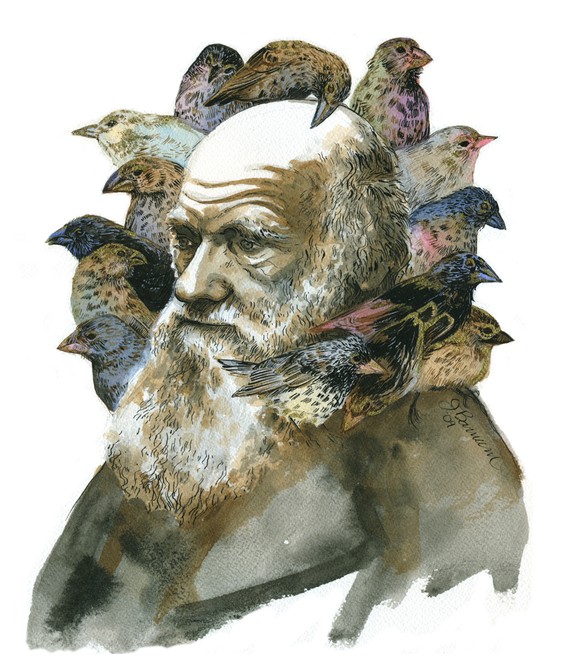When we come into this world, we usually emerge whole. Not everyone is as fortunate though. There are a variety of rare afflictions that push the embryo to develop in a haphazard way, causing damage most of us would turn our heads away from. Such damage can be the result of the slightest of changes in a gene that affects downstream biological processes in an infant's development, for instance. Frontonasal dysplasia is just one of these afflictions. A protein known as ALX1 is at the heart of this disease characterised by a face that is not only incomplete but, in the most extreme cases, split up the middle. Now imagine if humans had beaks... Then surely ALX1 would have an effect on a beak's development. This seems to be so. Recently, scientists discovered the ALX1 protein in finches known as Darwin's finches. These particular finches live on the Galápagos Islands and were originally described by Charles Darwin during his voyage on The Beagle. And it could well be that what characterises each species best - i.e. the shape of their beak - is the hallmark of ALX1.
In the mid-16th century, freak shows became popular in England. Typically, these shows exhibited people who, for the great majority, were born with biological irregularities - Lazarus whose twin brother dangled from his chest, Anna Swan the lady giant, and Joseph Merrick, otherwise known as Elephant Man, who suffered from gross deformities, besides the odd bearded woman or a microcephalic dwarf. A person suffering from frontonasal dysplasia, however, would not have had the same attraction because of the damage it can cause to a person's face, although there was one man - Sam Alexander - known as 'The Man with Two Faces', who had lost the lower part of his face following a gasoline explosion. Thanks to a lifelike mask he became a human curiosity in shows such as Barnum & Bailey where he would remove the mask to reveal the lack of face beneath.
The harm frontonasal dysplasia can do to a person's face is caused by something that has gone wrong very early on in embryonic development. The culprit is the ALX1 protein. Although we know that no protein ever acts on its own, ALX1 seems to have a direct - and perhaps the most primordial - role in facial development, which begins as early on as the fourth week in the human embryo. ALX1 protein is known as a homeobox protein because it has a specific domain on it called a homeodomain, which is capable of recognising and binding to a particular bit of DNA.

Characteristically, such proteins control the expression of genes and are hence responsible for the accurate unfurling of any downstream biological pathway. And if they go wrong, what comes after goes wrong too, much in the way a conductor who has forgotten how to direct an orchestra causes each musician to lose track of the symphony. In its natural state, AXL1 orchestrates the development of our nose, our mouth and our jaw. When it doesn't work properly, this whole part of our face is affected; sometimes in the most extreme ways.
So what does this have to do with Darwin's finches? Darwin's finches are historically distinguished from one another by the shape of their beaks. Though frequently described as the species that provided the basis for Darwin's theory of evolution, this is not exactly the case. The term "Darwin's finches" became popular following the publication, in 1947, of the British evolutionary biologist David Lack's eponymous book. But apparently the Galápagos finches were not mentioned in the first edition of Charles Darwin's "On the Origin of Species". They were, however, described in his journal in which he noted that they had probably all derived from a common ancestor from the South American continent. And over millions of years, each island had produced its own variety of finch. These observations were based on the finches' beaks whose shape varied depending on the nutrients available. A long slim beak is good for insects, while a short large beak is better for nuts. But Darwin hadn't yet thought up the mechanism which could explain how one beak could "become" another.
The Galápagos Islands offer a very special terrain for evolution since they are isolated from one another purely by distance. This made it difficult for birds to interbreed because it was simply too far to fly from one island to another. What is more, each island was, and continues to be, immersed in its own particular environment - volcanic activity, climate, sea level, glacial and interglacial cycles. As a result, over time about fourteen different species arose, with the most primitive split occurring about 900,000 years ago. Darwin had noticed and described all this but seemingly had no idea what it was that underlay beak transformation, and hence speciation. Although without a doubt these observations were amongst the many others he made of creatures, which ultimately led him to his theory of natural selection.
Recently, scientists carried out genetic analysis on 120 birds that they collected on the Galápagos Islands, which together represented the different species that are known. They discovered a gene that had a major effect on beak shape - which turned out to be the equivalent of ALX1 already known in humans.
Such knowledge is essential for all sorts of studies linked to evolution, such as speciation and population migration. On the medical front, getting to know genes such as ALX1 better, and what an altered form of the gene can cause, will help to assist in prenatal diagnosis. As an illustration, studies on ALX1 were done on a Turkish family whose parents were consanguineous and whose first child suffered from frontonasal dysplasia. The mother had two further pregnancies that were both interrupted because both embryos carried the ALX1 mutation.

